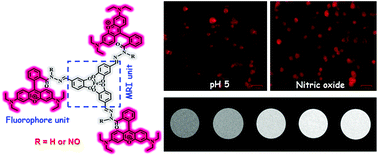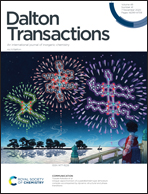Abstract
A rhodamine appended Fe(III)-catecholate complex Fe(RhoCat)3 is reported as a smart dual-modal T1 MRI-optical imaging probe. The high spin Fe(III) coordination sphere and rhodamine unit act as MRI and optical reporters, respectively. The probe showed a r1-relaxivity of 4.37 mM−1 s−1 at 1.41 T via the interaction of second sphere water molecules to coordinated oxygen atoms. It produced an enhanced signal intensity of phantom images on the 7.0 T animal research MRI/MRS scanner at 25 °C and pH 7.3. The interaction of the probe with bovine serum albumin (BSA) significantly improved r1 relaxivity (7.09 mM−1 s−1). Moreover, the optical imaging reporter rhodamine moiety exhibited sensitivity towards biomolecule nitric oxide (NO) and acidic pH via the formation of a ring-opened tautomer of rhodamine, wherein the r1 relaxivity of the probe was enhanced to 5.19 mM−1 s−1 for NO and slightly decreased for acidic pH. Further, the probe visualized NO in adenocarcinoma gastric (AGS) cells via a turn-on fluorescence mechanism with 80% cell viability. Thus, Fe(RhoCat)3 is demonstrated as a potential dual “MRI-ON and Fluorescence-ON” molecular imaging probe to visualize the NO molecule and acidic pH in the tumour microenvironment.



 Please wait while we load your content...
Please wait while we load your content...